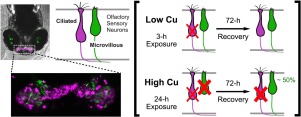当前位置:
X-MOL 学术
›
Neurotoxicology
›
论文详情
Our official English website, www.x-mol.net, welcomes your
feedback! (Note: you will need to create a separate account there.)
Differential copper-induced death and regeneration of olfactory sensory neuron populations and neurobehavioral function in larval zebrafish.
NeuroToxicology ( IF 3.4 ) Pub Date : 2018-10-04 , DOI: 10.1016/j.neuro.2018.10.002 Eva Y Ma 1 , Kevin Heffern 1 , Julia Cheresh 1 , Evan P Gallagher 1
NeuroToxicology ( IF 3.4 ) Pub Date : 2018-10-04 , DOI: 10.1016/j.neuro.2018.10.002 Eva Y Ma 1 , Kevin Heffern 1 , Julia Cheresh 1 , Evan P Gallagher 1
Affiliation

|
Fish rely heavily on their sense of smell to maintain behaviors essential for survival, such as predator detection and avoidance, prey selection, social behavior, imprinting, and homing to natal streams and spawning sites. Due to its direct contact with the outside environment, the peripheral olfactory system of fish is particularly susceptible to dissolved contaminants. In particular, environmental exposures to copper (Cu) can cause a rapid loss of olfactory function. In this study, confocal imaging of double-transgenic zebrafish larvae with differentially labeled ciliated and microvillous olfactory sensory neurons (OSNs) were used to examine cell death and regeneration following Cu exposure. Changes in cell morphologies were observed at varying degrees within both ciliated and microvillous OSNs, including the presence of round dense cell bodies, cell loss and fragmentation, retraction or loss of axons, disorganized cell arrangements, and loss of cells and fluorescence signal intensity, which are all indicators of cell death after Cu exposure. A marked loss of ciliated OSNs relative to microvillous OSNs occurred after exposure to low Cu concentrations for 3 h, with some regeneration observed after 72 h. At higher Cu concentrations and 24-h exposures, ciliated and microvillous OSNs were damaged with increased severity of injury with longer Cu exposures. Interestingly, microvillous, but not ciliated OSNs, regenerated rapidly within the 72-h time period of recovery after death from Cu exposure, suggesting that microvillous OSNs may be replaced in lieu of ciliated OSNs. An increase in bromodeoxyuridine labeling was observed 24 h after Cu-induced OSN death, suggesting that increased proliferation of the olfactory stem cells replaced the damaged OSNs. Olfactory behavioral analyses supported our imaging studies and revealed both initial loss and restoration of olfactory function after Cu exposures. In summary, our studies indicate that following zebrafish OSN damage by Cu, regeneration of microvillous OSNs may occur exceeding ciliated OSNs, likely via increased proliferation of the cellular reservoir of neuronal OSC precursors. Transgenic zebrafish are a valuable tool to study metal olfactory injury and recovery and to characterize sensitive olfactory neuron populations in fish exposed to environmental pollutants.
中文翻译:

幼虫斑马鱼中铜诱导的嗅觉感觉神经元种群的死亡和再生以及神经行为功能的差异。
鱼在很大程度上依靠其嗅觉来维持生存所必需的行为,例如掠食者的发现和躲避,猎物的选择,社交行为,烙印以及归巢到幼体和产卵场所。由于其直接与外部环境接触,鱼类的外围嗅觉系统特别容易受到溶解污染物的影响。特别是,环境中暴露于铜(Cu)会导致嗅觉功能快速丧失。在这项研究中,共聚焦成像的双转斑马鱼幼虫与差异标记的纤毛和微毛嗅觉感觉神经元(OSNs)用于检查细胞暴露后铜的死亡和再生。在纤毛和微绒毛的OSNs中都观察到了不同程度的细胞形态变化,包括圆形致密细胞体的存在,细胞丢失和破碎,轴突收缩或丢失,细胞排列紊乱,细胞丢失和荧光信号强度,这些都是暴露于铜后细胞死亡的指标。暴露于低铜浓度3 h后,纤毛OSN相对于微绒毛OSN明显损失,在72 h后观察到一些再生。在较高的铜浓度和24小时的暴露下,纤毛和微绒毛的OSN受到损害,而随着暴露时间的延长,伤害的严重性增加。有趣的是,微绒毛而不是纤毛OSN在因暴露于铜而死亡后的72小时内迅速再生,这表明微绒毛OSN可以代替纤毛OSN。铜诱导的OSN死亡24小时后,溴脱氧尿苷标记增加,这表明嗅觉干细胞增殖的增加取代了受损的OSN。嗅觉行为分析支持了我们的影像学研究,并揭示了铜暴露后嗅觉功能的最初丧失和恢复。总而言之,我们的研究表明,在斑马鱼OSN被Cu破坏后,微毛OSN的再生可能超过纤毛OSN,这可能是由于神经元OSC前体细胞蓄积池的增殖所致。转基因斑马鱼是研究金属嗅觉损伤和恢复以及表征暴露于环境污染物的鱼类中敏感嗅觉神经元种群的宝贵工具。嗅觉行为分析支持了我们的影像学研究,并揭示了铜暴露后嗅觉功能的最初丧失和恢复。总而言之,我们的研究表明,在斑马鱼OSN被Cu破坏后,微毛OSN的再生可能超过纤毛OSN,这可能是由于神经元OSC前体细胞蓄积池的增殖所致。转基因斑马鱼是研究金属嗅觉损伤和恢复以及表征暴露于环境污染物的鱼类中敏感嗅觉神经元种群的宝贵工具。嗅觉行为分析支持了我们的影像学研究,并揭示了铜暴露后嗅觉功能的最初丧失和恢复。总而言之,我们的研究表明,在斑马鱼OSN被Cu破坏后,微毛OSN的再生可能超过纤毛OSN,这可能是由于神经元OSC前体细胞蓄积池的增殖所致。转基因斑马鱼是研究金属嗅觉损伤和恢复以及表征暴露于环境污染物的鱼类中敏感嗅觉神经元种群的宝贵工具。
更新日期:2018-10-04
中文翻译:

幼虫斑马鱼中铜诱导的嗅觉感觉神经元种群的死亡和再生以及神经行为功能的差异。
鱼在很大程度上依靠其嗅觉来维持生存所必需的行为,例如掠食者的发现和躲避,猎物的选择,社交行为,烙印以及归巢到幼体和产卵场所。由于其直接与外部环境接触,鱼类的外围嗅觉系统特别容易受到溶解污染物的影响。特别是,环境中暴露于铜(Cu)会导致嗅觉功能快速丧失。在这项研究中,共聚焦成像的双转斑马鱼幼虫与差异标记的纤毛和微毛嗅觉感觉神经元(OSNs)用于检查细胞暴露后铜的死亡和再生。在纤毛和微绒毛的OSNs中都观察到了不同程度的细胞形态变化,包括圆形致密细胞体的存在,细胞丢失和破碎,轴突收缩或丢失,细胞排列紊乱,细胞丢失和荧光信号强度,这些都是暴露于铜后细胞死亡的指标。暴露于低铜浓度3 h后,纤毛OSN相对于微绒毛OSN明显损失,在72 h后观察到一些再生。在较高的铜浓度和24小时的暴露下,纤毛和微绒毛的OSN受到损害,而随着暴露时间的延长,伤害的严重性增加。有趣的是,微绒毛而不是纤毛OSN在因暴露于铜而死亡后的72小时内迅速再生,这表明微绒毛OSN可以代替纤毛OSN。铜诱导的OSN死亡24小时后,溴脱氧尿苷标记增加,这表明嗅觉干细胞增殖的增加取代了受损的OSN。嗅觉行为分析支持了我们的影像学研究,并揭示了铜暴露后嗅觉功能的最初丧失和恢复。总而言之,我们的研究表明,在斑马鱼OSN被Cu破坏后,微毛OSN的再生可能超过纤毛OSN,这可能是由于神经元OSC前体细胞蓄积池的增殖所致。转基因斑马鱼是研究金属嗅觉损伤和恢复以及表征暴露于环境污染物的鱼类中敏感嗅觉神经元种群的宝贵工具。嗅觉行为分析支持了我们的影像学研究,并揭示了铜暴露后嗅觉功能的最初丧失和恢复。总而言之,我们的研究表明,在斑马鱼OSN被Cu破坏后,微毛OSN的再生可能超过纤毛OSN,这可能是由于神经元OSC前体细胞蓄积池的增殖所致。转基因斑马鱼是研究金属嗅觉损伤和恢复以及表征暴露于环境污染物的鱼类中敏感嗅觉神经元种群的宝贵工具。嗅觉行为分析支持了我们的影像学研究,并揭示了铜暴露后嗅觉功能的最初丧失和恢复。总而言之,我们的研究表明,在斑马鱼OSN被Cu破坏后,微毛OSN的再生可能超过纤毛OSN,这可能是由于神经元OSC前体细胞蓄积池的增殖所致。转基因斑马鱼是研究金属嗅觉损伤和恢复以及表征暴露于环境污染物的鱼类中敏感嗅觉神经元种群的宝贵工具。









































 京公网安备 11010802027423号
京公网安备 11010802027423号